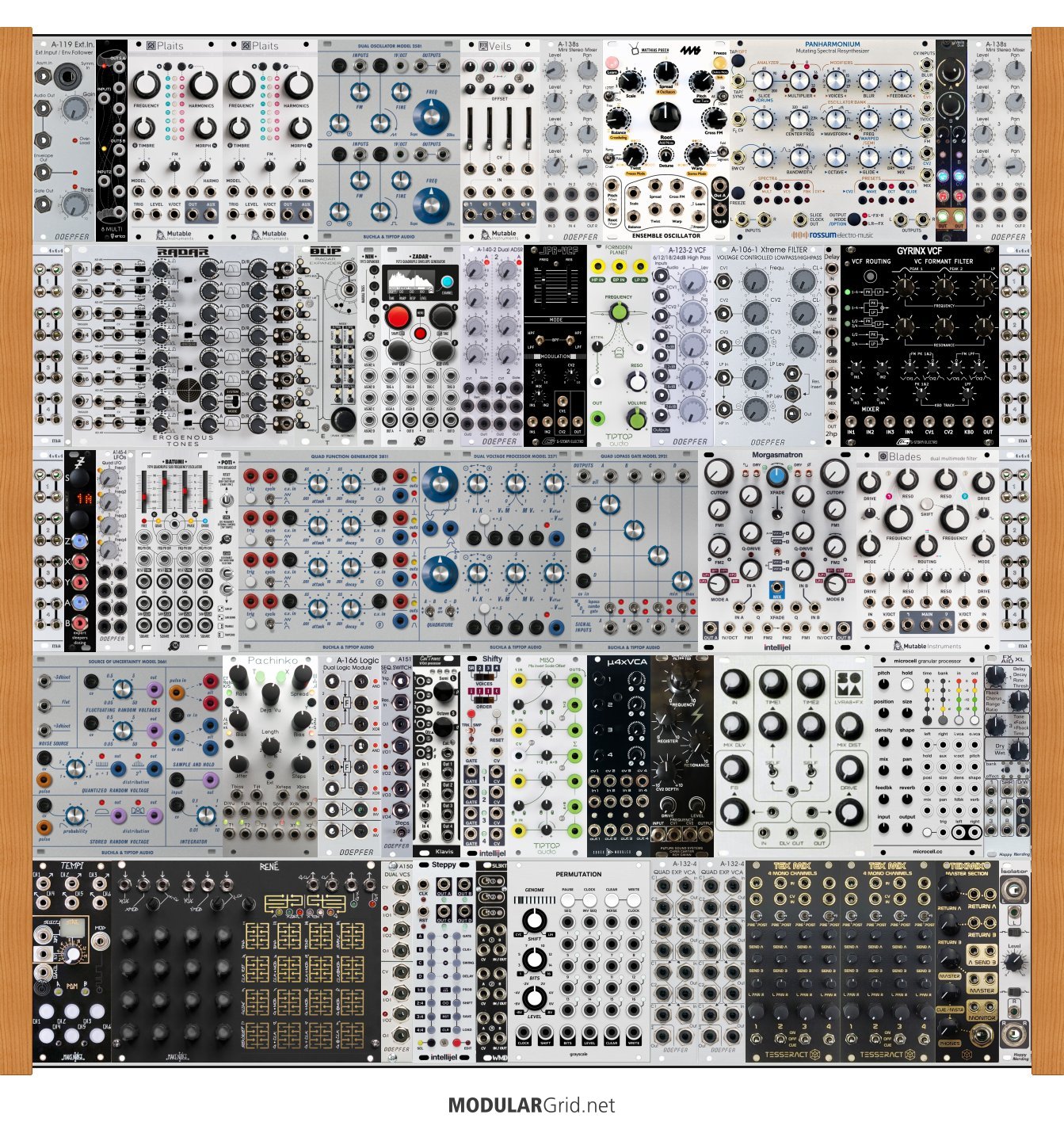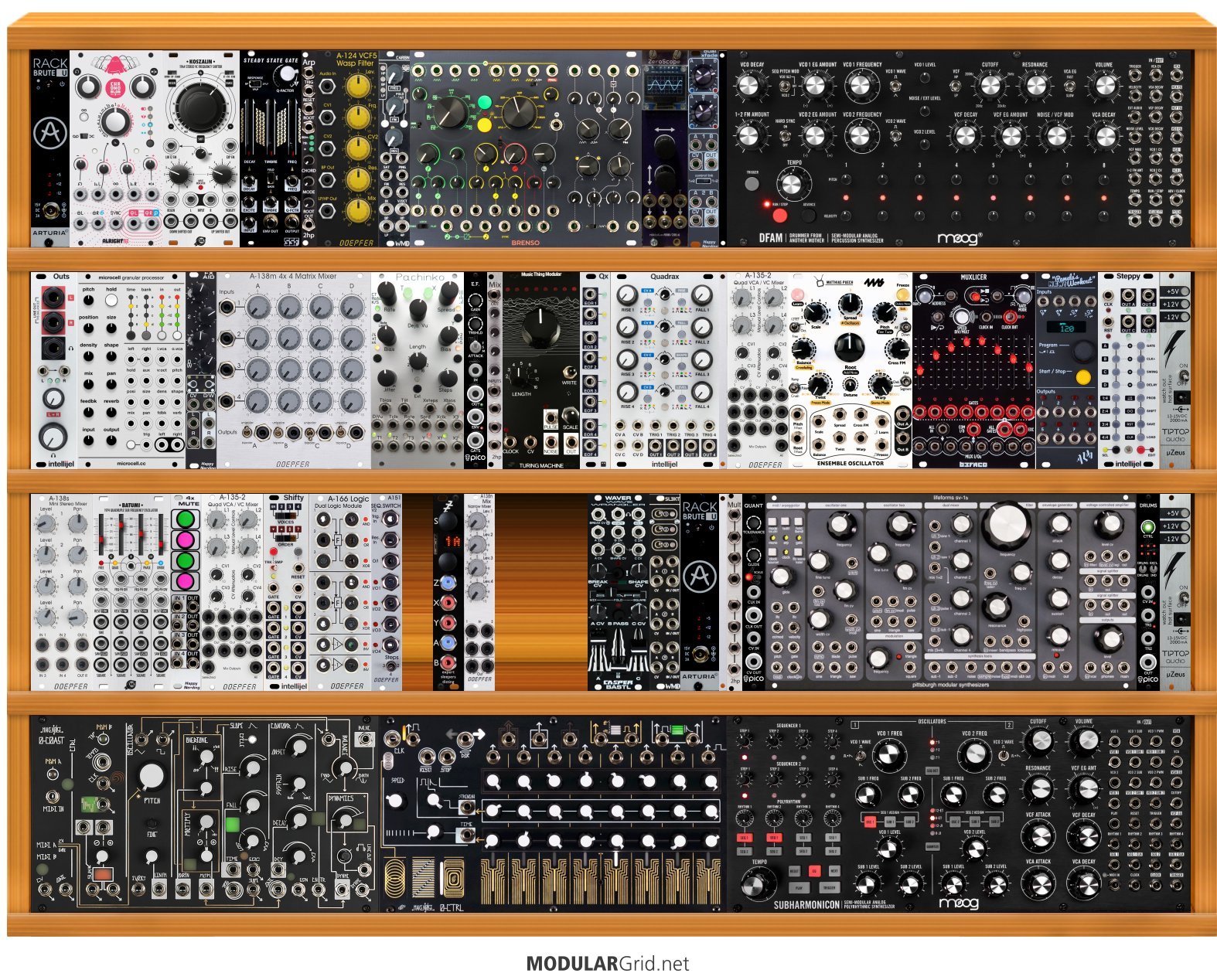Done! I opted for a total rebuild, since it seems that you're aiming more for ideas. So, this is actually in a different case, since I know what a PITA it is to haul buttloads of small boxes. I opted to redo the entire thing in THIS: https://reverb.com/item/38708935-15u-126-hp-84-104-hp-or-other-eurorack-portable-case-powered-modular-synthesizer-patched-reseal Case From Lake has this KILLER 126 hp x 5 cab with beefy Meanwells for about a grand, and it's small enough to still fit in an overhead compartment. Having the FIVE rows made the layout make a lot more sense, with the ability to get more space AND set up a coherent signal flow. So....

Note that all cased/powered devices have been removed.
ROW 1: Added a Doepfer A-119 for an external audio in + envelope follower. Then there's an Erica 2x4/1x8 buffered mult because we've got a load of stuff here that might need it. After that, a PAIR of Plaits is tandemmed with a Buchla 258t for loads of FM and klangy fun. These feed a Veils, with a VCA for each VCO out, and then this hits a Doepfer A-138s. After that set, you then have the 4ms Ensemble Oscillator feeding a Rossum Panharmonium...this combo will output one of the thickest, juiciest sounds ever. This goes through an After Later dual VCA based on the Veils topology, and after that is a second Doepfer A-138s. The second mixer is there in case you want to add ALL sources...send the first mixer's out to 1 and 2, then the 4ms/Rossum/After Later combo can go to 3 and 4, with a resulting stereo out combining ALL oscillator sources if desired.
ROW 2: This is envelopes and character filters. This row has a Manhattan x4 mult at both ends. Then you've got Erogenous Tones' awesome RADAR/PING combo. Imagine a multiple EG sequencer. Yeah. All eight of the EGs in the RADAR can be controlled from the PING...a really over the top AR generator! Zadar and Nin next...this is your "programmable" EGs, with four of those out. Then I put the Doepfer A-140-2 back so that you can have a pair of easily-tweakable ADSRs. Then, for character VCFs, I added a G-Storm Jupiter-6 clone, a Tiptop Forbidden Planet (Steiner Synthacon VCF clone...HOWLING leads!), a Doepfer HPF...and then, see that filter and the 2hp delay? They're the same thing, actually; the Doepfer A-106-1 is not only a clone of the Korg MS-20's Sallen-Key pair, it has a very eeeeeeeevil little addition: an INSERT in the resonance path, which is what the delay's there for. Imagine echoes that gradually get more and more lo-fi and glitchy. That. But the best is last: a G-Storm clone of the famous Syrinx VCF...which also has a 4-in mixer on front, so if you wanted, you could mix all four of those at the Gyrinx VCF and THEN impose all of these various formant spectra onto it via the Gyrinx.
ROW 3: Modulation and "main" stereo VCFs. Again, this row is bookended by those Manhattan mults. We start with the Disting, which I've positioned for use by a number of different control modules. Then the little Quad LFO from Doepfer, followed by your Batumi, which I've added the Poti expander to here. Then there's a Buchla 281t for not only 2-stage envelopes on loop or one-shot...but this can also output quadrature-shifted modulation. Twice, actually...two EGs per quadrature output. And why stop there with the Buchla stuff, so next is their 257t...one of the best CV manglers around. Then where the filters start, I put in that famous Buchla "ploonk" via a 292t Quad Lowpass Gate. As for the main stereo VCFs, I picked some winners: Intellijel's Morgasmatron and Mutable's Blades.
ROW 4: More Buchla-in-yer-face! This starts with the famous Buchla Source of Uncertainty, which includes noise, sample and hold, and of course all of Don's wild randomness voodoo. The Marbles clone follows this, as it might be fun to generate even further randomization of already-randomized CVs. Generative? Hellz yeah! Logic's next, then the 4-1 sequential switch, and after that is Klavis's CalTrans, a quad quantizer. Since the sequential switch can either go 1 to 4 OR 4 to 1, this lets you choose if you want to switch between single input sources, or to switch four signals across one output. I opted to follow that with Intellijel's Shifty, a quad analog shift register...this replaced the arpeggiator, as you can do things like that with this module, or just go totally off and ping CVs all over the place. The MISO actually is part of the row 3 complement, but I put it down lower for better tweaking and because the space simply wasn't there in row 3. It's a killer polarizer/mixer/scrambler for modulation. Then I put in a Veils clone (due to space limitations) for some modulation-dedicated VCAs. After that are effects, starting with the Gristleizer VCF (I couldn't make the TG VCA go in there, sadly), then the Soma dual delay, and then your Microcell. The row closes out with the full FX Aid.
ROW 5: Sequencing and control. This starts with the Tempi/Rene combo. Those two modules are designed to work together via backplane connections, and replicate the primary functions of the Pam's while, at the same time, offering a 4 x 4 pad sequencer/controller. I put the dual VCS after that so that you can bounce around the Rene outputs, etc easily. The Steppy follows this, providing clocked sequential pulses over four channels (and you'll notice how close it is to the Doepfer sequential switch...hint hint). This is then followed by the triple switch, letting you scramble between sources. Given the amount of sequencing and clocking, this set of switches can function as a sort of sequential source router if needed...aside of a bunch of other possible things. Then I went all in on the random sequencer with the next-gen Turing Machine, a full version of the Greyscale Permutations. After this, there's eight exponential VCAs to act as the "front ends" for the final mixer, where I opted for one of Jim's faves, the Tesseract TexMix series...in this case, a pair of mono input modules and the master module. This not only gives you eight mono channels, you have two mono AUX sends and two stereo returns, plus a master fader and your headphone preamp. Using this, you can parallel the effects over the mix, instead of being reliant on the 'wet/dry' controls. And last but not least, Happy Nerding's Isolator, which gives you transformer isolation from external crud AND a transformer that you can hit a little harder so that you get that tasty "big iron" sound.
No power supplies? Right. This CFL sucker has that more than covered. Need more? Have CFL toss another Meanwell in that thing. And of course, this follows an up-left/down-right pattern, which has the modulation and CV coming up from the left side, with the audio going back down toward the TexMix on the right via the VCFs. And if it seems that this is a little underequipped, keep in mind that you can always break out the character filters as mono devices and send them on to the TexMix.
This isn't bad...and given that I also made it portable (yeah! 15U and portable!) means that you've now got a potent boxful of stuff and things that you can fold up and tote yourself. So, that's how I would approach this as a full rework.


